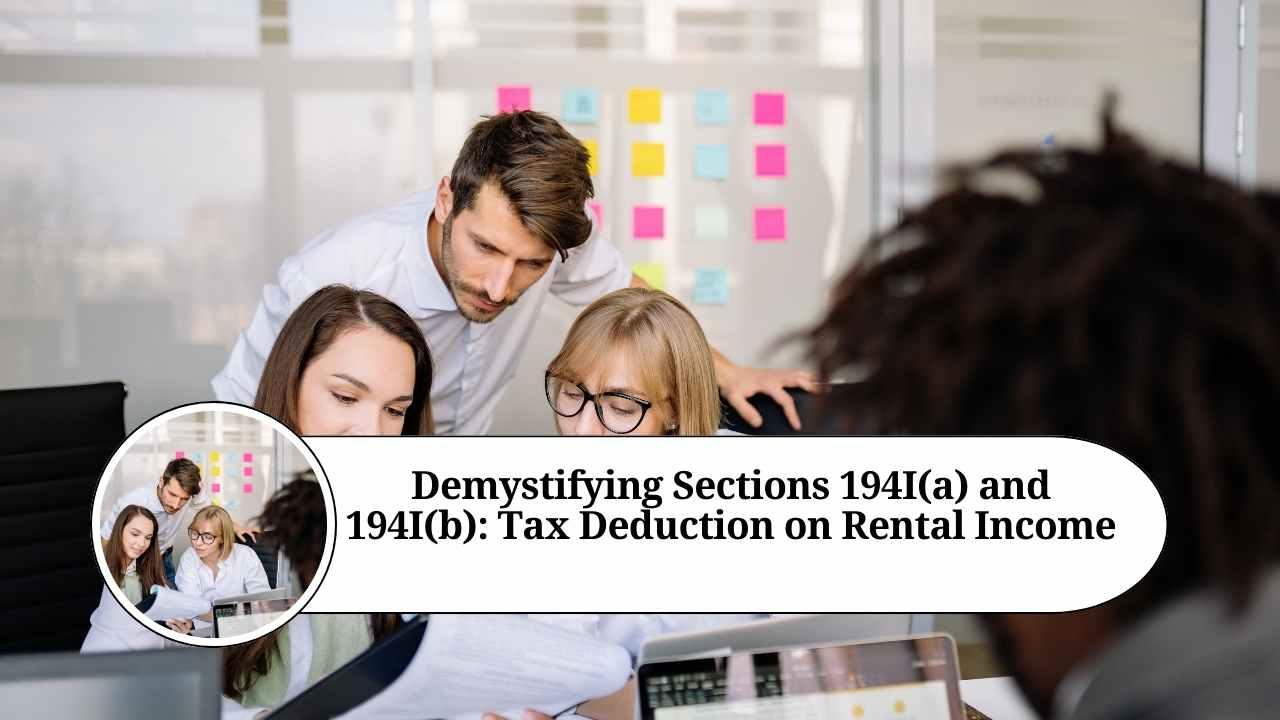
Introduction:
Tax regulations can often be complex and confusing, particularly when it comes to understanding the various sections and provisions within the Income Tax Act. Two such sections, 194I(a) and 194I(b), pertain to the deduction of tax at source on rental income and are crucial for both landlords and tenants to comprehend. In this blog, we will delve into the details of these sections, highlighting their implications and providing clarity on their applicability.
Section 194I(a):
Section 194I(a) of the Income Tax Act addresses the deduction of tax at source on rental income from land, buildings, or plant and machinery. This provision mandates the tenant to withhold a specific percentage of the rental payment as tax and deposit it with the government. Let’s explore the key aspects of this section:
Bạn đang xem: Demystifying Sections 194I(a) and 194I(b): A Comprehensive Guide to Tax Deduction on Rental Income
- Applicability: Section 194I(a) is applicable when the aggregate annual rent exceeds Rs. 2,40,000. If the rental payment exceeds this threshold, the tenant is obligated to deduct tax at source.
- Rate of TDS: The prescribed rate of tax deduction at source under section 194I(a) is 10% of the rent amount. However, if the payee does not provide their Permanent Account Number (PAN), the rate increases to 20%.
- Time of Deduction and Deposit: The tenant must deduct the tax at source at the time of payment or credit, whichever is earlier. The deducted tax must be deposited with the government within the specified due dates.
Section 194I(b):
Section 194I(b) deals with the deduction of tax at source on rental income from plant and machinery other than those covered under section 194I(a). It applies to situations where a separate provision for TDS on machinery or equipment rentals is necessary. Here are the key points related to this section:
- Applicability: Section 194I(b) is applicable to rentals paid for the use of plant, machinery, or equipment, excluding those covered under section 194I(a). It includes items such as motor vehicles, computers, office equipment, etc.
- Rate of TDS: Similar to section 194I(a), the prescribed rate of tax deduction at source under section 194I(b) is 10% of the rental amount. The rate increases to 20% if the payee fails to provide their PAN.
- Time of Deduction and Deposit: The tenant must deduct the tax at source at the time of payment or credit, whichever is earlier, and deposit it with the government within the specified due dates.
Conclusion:
Understanding the provisions of section 194I(a) and 194I(b) is essential for both tenants and landlords to ensure compliance with tax regulations. It is crucial to be aware of the applicability thresholds, the rates of tax deduction, and the timelines for depositing the deducted tax with the government.
For tenants, it is important to calculate the rental income and identify if the thresholds mentioned in section 194I(a) or 194I(b) are crossed. If they are, the tenant must deduct the applicable tax at source and deposit it with the government within the specified timelines.
Xem thêm : 10 Lines on Subhash Chandra Bose: छात्रों के लिए सुभाष चंद्र बोस के बारे में 10 लाइन
Landlords should also be mindful of providing their PAN to tenants to avoid higher rates of tax deduction. Additionally, they must ensure they report the rental income correctly in their tax returns to account for the deducted tax.
By familiarizing yourself with the provisions of sections 194I(a) and 194I(b), you can navigate the complexities of rental income taxation and fulfill your obligations as a tenant or landlord, while staying compliant with the Income Tax Act.
Frequently Asked Questions (FAQs)
Q: What is the threshold for the applicability of Section 194I(a)? A: Section 194I(a) is applicable when the aggregate annual rent exceeds Rs. 2,40,000.
Q: What types of properties are covered under Section 194I(a)? A: Section 194I(a) covers rental income from land, buildings, and plant and machinery.
Q: What is the rate of tax deduction at source under Section 194I(a)? A: The prescribed rate of tax deduction at source under Section 194I(a) is 10% of the rent amount.
Q: What happens if the payee does not provide their PAN under Section 194I(a)? A: If the payee does not provide their PAN, the rate of tax deduction at source increases to 20%.
Xem thêm : World Meteorological Day
Q: When should the tenant deduct and deposit the tax under Section 194I(a)? A: The tenant must deduct the tax at source at the time of payment or credit, whichever is earlier, and deposit it within the specified due dates.
Q: What types of rentals are covered under Section 194I(b)? A: Section 194I(b) covers rentals for the use of plant, machinery, or equipment other than those covered under Section 194I(a). It includes items like motor vehicles, computers, office equipment, etc.
Q: What is the rate of tax deduction at source under Section 194I(b)? A: The rate of tax deduction at source under Section 194I(b) is also 10% of the rental amount.
Q: Does the rate of tax deduction increase if the PAN is not provided under Section 194I(b)? A: Yes, similar to Section 194I(a), the rate of tax deduction increases to 20% if the payee fails to provide their PAN under Section 194I(b).
Q: When should the tenant deduct and deposit the tax under Section 194I(b)? A: The tenant must deduct the tax at source at the time of payment or credit, whichever is earlier, and deposit it within the specified due dates.
Q: Is it necessary for landlords to report rental income in their tax returns? A: Yes, landlords are required to report rental income in their tax returns, taking into account the deducted tax. It is important to accurately report the rental income to ensure compliance with tax regulations.
Nguồn: https://nanocms.in
Danh mục: शिक्षा









